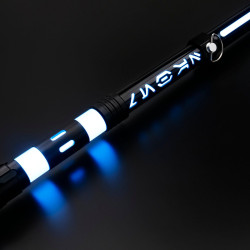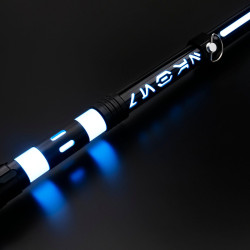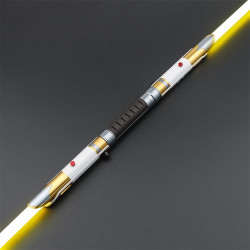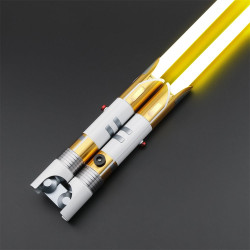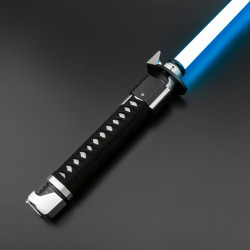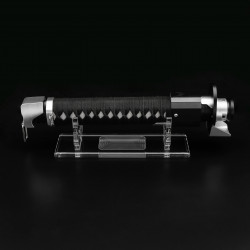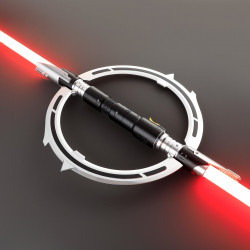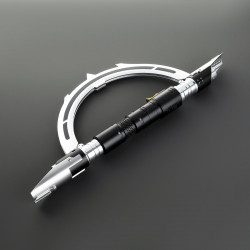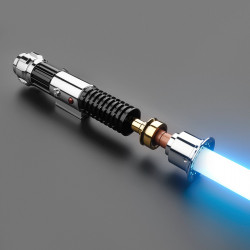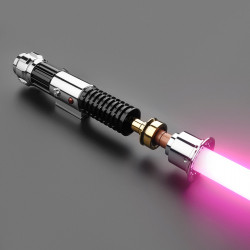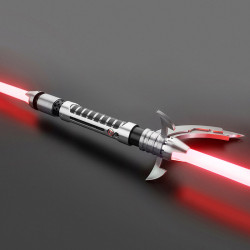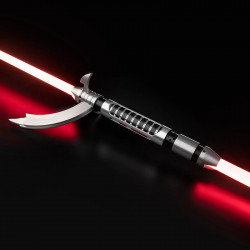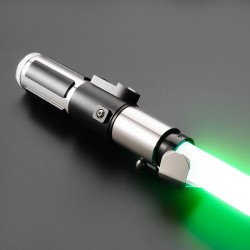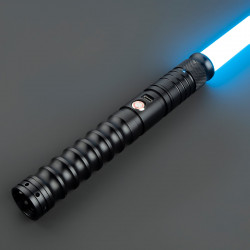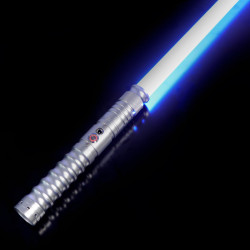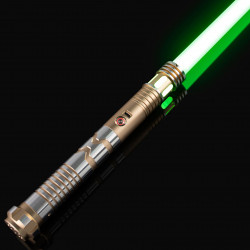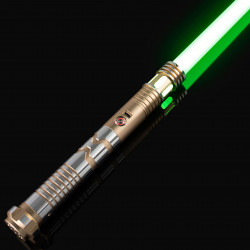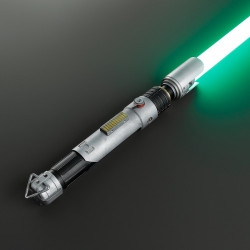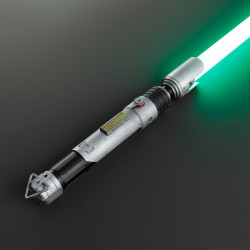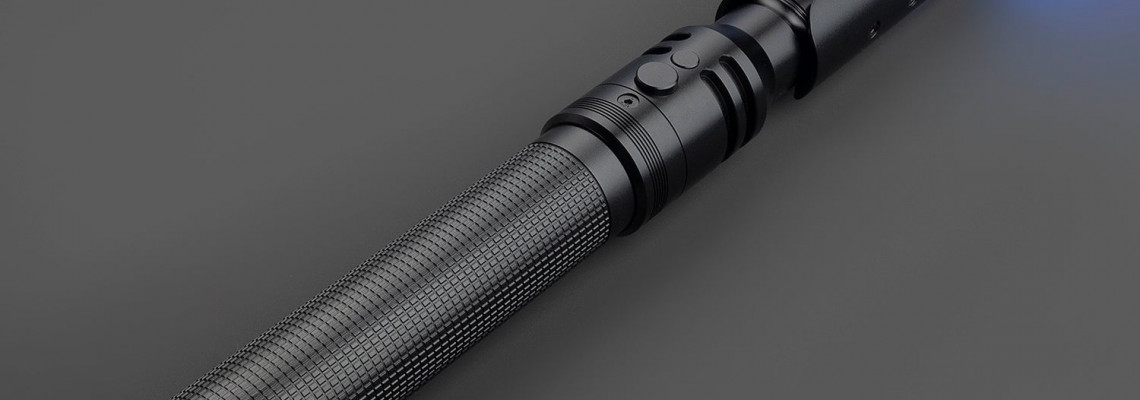
Lightsaber Combat: A Comprehensive Guide
What is Lightsaber Combat?
The discipline of lightsaber combat was made up of many martial arts that were created especially for lightsaber combat, though it was not confined to that. These fighting styles were required in order to confront and capitalize on the unique features of lightsabers, especially their peculiar balance—all of the weapon's weight is concentrated in the hilt—and their omnidirectional cutting edge.
The Jedi Order's seven forms were among the most prominent in terms of lightsaber fighting. However, other bands have developed their own looks and methods, including the Sith's Dun Möch method.
Since they frequently arose in response to changing weaponry technology, the specific goals and methods of these combat forms were greatly impacted by the eras in which they were created. In the era when Dark Jedi and renegade Force-sensitives were common, for example, the Duelling-focused Makashi form was created, which resulted in many lightsaber battles.
However, the creation of Soresu took place during a time when lightsaber battles were uncommon, and Jedi were more frequently confronted by opponents brandishing blasters and other ranged attacks.
What Is the History Behind the Lightsaber Forms?
By 7000 BBY, the Jedi Order had made lightsabers their standard weapon as the technology developed and became useful. Although the lightsaber retained many aspects of conventional fencing, its development required a combat style that was adapted to the weapons' strengths and limitations. A simplified style based on traditional fencing methods, Form I, or Shii-Cho, defined attack types, parries, body zones, and drills especially made for lightsaber use.
Shii-Cho, however, was unable to compete effectively in lightsaber-to-lightsaber combat as Dark siders and fallen Jedi started to appear, resulting in regular lightsaber battles. This resulted in the development of Form II, Makashi, a precise and effective Duelling form designed for these kinds of clashes. Some of the galaxy's best Duelling masters, like Makashi, created the early Sith Lord Tulak Hord at this time.
Later, as blasters and other ranged energy weapons became more common, Takashi became less common. Soresu, Form III, was created to handle this change in warfare. Building on Shii-Cho's blast-deflection training, Soresu concentrated on defensive covering, which is defined by precise, effective motions. An absolute master of Form III was regarded by many as being almost unbeatable despite the style's focus on defense rather than attack.
Ataru (Form IV) and Shien (Form V), two aggressive combat forms, were created simultaneously to compensate for Soresu's alleged deficiencies. Shien concentrated on power and offensive strategies, particularly using the lightsaber's capacity to redirect blaster bolts back at adversaries, while Ataru prioritized speed and agility. Djem So, a more sophisticated variation of Form V that prioritized aggressive lightsaber battling, was eventually developed.
Even while Forms IV and V were very powerful, their aggressiveness made many of the more conventional Jedi uncomfortable. They created Form VI, Niman, in search of a more well-rounded strategy that was more in line with Jedi doctrine. Originating from the Jar' Kai dual-blade fighting style, this form provided a route to remarkable lightsaber proficiency without depending on strength or Force. Niman was dubbed the "diplomat's form," but paradoxically, it ended up being the go-to look for the fierce duelist Exar Kun, a former Jedi who is now a Sith Lord.
Though he was sure of his skills and thought he was the best duelist in the galaxy, Kun was eventually defeated by Djem So from expert Ulic Qel-Droma. Kun was one of the first to use a saber staff, which he made using schematics from a Sith Holocron, and would go on to defeat Vodo-Siosk Baas, the Jedi Battle master of the time.
The development of Form VII, Juyo, was completed during the First Jedi Purge. The Sith's emphasis on combat skill was perilously near to this sophisticated and highly aggressive form, which necessitated mastery of several other forms. Juyo combined Niman's fluidity, Shien's tight, forceful movements, and Makashi's deft footwork.
Juyo's brutal nature meant that it was rarely taught, especially to people with a reckless disposition. As a result, it remained underdeveloped for almost a millennium after the dissolution of the Army of Light due to the Ruusan Reforms. Jedi Masters Vrook Lamar, Zez-Kai Ell, Kavar, and Atris were among the few known individuals who practiced Juyo following the First Jedi Purge.
How Did Lightsaber Combat Change During the Sith Resurgence?
The Jedi were once again at odds with their long-standing enemies on a large scale with the start of the Great Galactic War and the return of the ancient Sith Empire. As early as the Jedi Civil War, the Sith Lords continued to have access to the classic lightsaber forms during this time.
Notable Sith was known to study Forms VII, IV, and III, including the Emperor's Wrath Scourge. During this period, the Sith probably created their distinctive fighting techniques, although there are few records of these developments.
In order to satisfy the harsh requirements of this perilous time, which saw frequent and fierce battles between Jedi and Sith, the Jedi transformed the already lethal Form VII into Juyo-Kos in reaction to the Sith menace. According to Jerbhen Hulis's comments during his brief combat with Teneb Kel, this viewpoint is supported.
Jaric Kaedan, a master of the Form VII variety, and Orgus Din, who developed his advanced skills via an unrelenting effort to make up for his inferior Force connection, were two notable duelists of this era.
Vindican and Malgus were two of the first Sith Lords to engage in combat with Jedi in more than three millennia. They did so against Kao Cen Darach and Satele Shan, who would go on to become the Jedi Grand Master.
Kas'im, a Twi'lek duelist, became a well-known Sith figure during the New Sith Wars. He was the lightsaber instructor at the Korriban Academy for the Brotherhood of Darkness. Darth Bane was among the many outstanding duelists who were his pupils.
Bane had no training against Jar' Kai dual-blade combat. Therefore, Kas'im's proficiency in it provided him with an advantage when Bane finally turned against the Brotherhood and faced him. Though he was ultimately victorious because of his superior Force command, Bane considered Kas'im to be the best duelist of the time, if not the best ever. Raskta Lsu, Kas'im's Jedi equivalent, was later killed by Bane.
How Did Lightsaber Combat Evolve After the Ruusan Reformation?
Jedi lightsaber combat changed significantly after the Sith and other Dark sider groups were decimated or driven into hiding following the final battle of Ruusan.
The lack of foes with lightsabers and the Makashi form's inefficiency versus blaster-wielding opponents rendered the dueling-focused form obsolete. Different weapon types also became less popular; by 32 BBY, it was almost unheard of to employ double-bladed lightsabers in combat rather than training.
In spite of these modifications, the period gave rise to Yoda, one of the greatest lightsaber duelists in history. Throughout his nine hundred years of life, Yoda became proficient in all seven types of lightsaber combat, but his specialty was Ataru. This form's combat technique was a spectacular demonstration of Ataru's ideals since his acrobatic moves and broad swordplay made up for his low stature and limited reach.
Dooku, who continued to concentrate on Duelling despite Makashi's waning popularity because he believed it to be one of the best forms of fighting, was another well-known duelist of this era. Prior to giving up the lightsaber in favour of staff-fighting, which he believed to be a "purer" method, Siolo Ur Manka was also respected as a Jedi warrior.
Another outstanding Juyo-focused duelist of the time was Mace Windu. Due to the lack of duelists who possessed the self-control necessary for Form VII, the form remained incomplete, so he struggled to perfect it. As a result of Windu's efforts, the Vaapad style—named for a predator indigenous to the Sarapin moons—was created.
Vaapad was a perilous form that verged on evil; its practitioners had to enjoy the rush of combat, channeling their rage while stoking their opponent's aggression, which produced a potent feedback cycle. With the assistance of fellow Jedi sword master Sora Bulq, Windu created Vaapad, and he only taught the method to his Padawan, Depa Billaba.
During Quinlan Vos's retraining, Bulq notably introduced him to aspects of Vaapad, but he concealed the style's nature, and after learning more about it, Vos decided not to employ it.
Darth Maul, the pupil of Darth Sidious, was a superb duelist among the Sith. Maul, one of the best-trained Sith in the order's history, was an expert in a number of unusual fighting techniques, most notably a perverted Sith variation of Juyo.
Maul used a double-bladed lightsaber in addition to his skilled fighting abilities. He invented it after a disastrous battle with Siolo ur Manka made him realize that single-bladed lightsabers were too constricting. Due to his unconventional weaponry and the Jedi's lack of knowledge of it, Maul was able to defeat powerful Jedi like Qui-Gon Jinn and Anoon Bondara. Only when he let his defenses down against Obi-Wan Kenobi, Jinn's Padawan, did Maul lose the battle.
After Dooku departed the Jedi Order, Sidious looked for a new apprentice and named him Darth Tyranus, assuming Maul was dead. Anakin Skywalker, a young Jedi Order star, was being instructed by Obi-Wan Kenobi. His specialty was Form V, an aggressive fighting style that complemented Skywalker's audacious and combative personality.
But his quick development boosted his ego, making him think he could compete with Yoda. In a bloody combat, Tyranus amputated Skywalker's arm, shattering this arrogance after concluding that Ataru's lack of defense played a part in Qui-Gon Jinn's demise. Kenobi, on the other hand, concentrated on learning Soresu, a defensive form. Even while Soresu was efficient against enemies with blasters, Tyranus was too skilled for Kenobi, whose accurate blade work quickly got past his strong defenses.
What Impact Did the Clone Wars Have on Lightsaber Fighting Styles?
The Clone Wars brought about significant modifications to lightsaber combat because the Jedi had to develop specialized combat methods. After all, the moderate forms they had been used for generations were insufficient on the battlefield. Interestingly, every practitioner of Niman who took part in the Battle of Geonosis died in battle.
The fallen Jedi Sora Bulq and the Rattataki warlord Asajj Ventress were among the many accomplished duelists Dooku enlisted into his cadre of Dark Acolytes in preparation for the Sith-sponsored battle. Dooku gave Ventress more training, especially in the Makashi lightsaber form, after her remarkable lightsaber skills won the approval of both Sidious and Dooku.
Additionally, Dooku taught General Grievous, a Kaleesh cyborg, who became one of the most dangerous Jedi hunters of the time due to his improved speed and reflexes. He defeated prominent Jedi like Shaak Ti and Eeth Koth and struggled to a standstill with Mace Windu, all while collecting lightsabers as trophies. However, Mace Windu was the final master of Vaapad after the war claimed the lives of several notable duelists, such as Sora Bulq and Depa Billaba.
By the end of the conflict, Anakin Skywalker had killed Dooku, and Obi-Wan Kenobi had killed Grievous. With Dooku praising Skywalker as the best Djem So stylist he has ever seen and Mace Windu identifying Kenobi as "the Master of Soresu," their much-enhanced abilities made them two of the Jedi Order's best duelists.
When Windu confronted Darth Sidious—who turned out to be Palpatine, the Supreme Chancellor of the Republic—his Vaapad technique was finally put to the test. Jedi Masters Agen Kolar and Saesee Tiin were quickly dispatched by Sidious, thanks to his superior fighting abilities and Dark Side mastery.
Windu and Kit Fisto were left to fight the merciless Sith Lord; Fisto was murdered after just about holding Sidious at bay. Windu was then able to fully channel Vaapad, resulting in a power feedback loop that kept the two fighters engaged in a fierce duel. After gaining the upper hand, Windu disarmed Palpatine and appeared to have defeated him.
His triumph was short-lived, nonetheless, as Anakin Skywalker destroyed Windu's sword hand and betrayed the Jedi, leaving him open to Palpatine's Sith abilities. One of the Jedi Order's best duelists, second only to Yoda, Mace Windu, was dead.
As the leader of the attack on the Jedi Temple, Skywalker—now Darth Vader—killed numerous Jedi, including the younglings. Even the respected Jedi sword master and Council member Cin Drallig was unable to endure Vader's unrelenting rage for too long.
But Obi-Wan Kenobi, his old master, was Vader's equal. Kenobi's proficiency with the defensive Soresu form served as the ideal counterbalance to Vader's full-scale assault. In one of the greatest lightsaber duels ever, Kenobi surrendered ground strategically in front of Vader's unrelenting assault, leading the fight to a location of his choosing and winning the battle.
Vader overestimated his strength and tried to jump over Kenobi, but his former master amputated him and left him to perish on the beaches of a lava river in Must afar. Only after being saved by Palpatine, who had just returned from a combat with Yoda, did he live. After realizing that martial skill alone would not be sufficient to overthrow the emerging Sith Order, Kenobi and Yoda fled to Tatooine and Dagobah, respectively.
How Did the Great Jedi Purge Affect Lightsaber Combat?
The progress of lightsaber combat slowed significantly after the Jedi Order was virtually decimated, with the Sith driving the majority of these developments. The battle forms themselves, however, survived among the Sith, in holocron, and surviving documents. Darth Vader became a powerful force during this period.
Because of his bulky life-support equipment, Vader had to modify and improve his lightsaber skills. To counter the more acrobatic fighting styles preferred by the remaining Jedi, his final combat form combined aspects of multiple techniques, relying on physical strength and accuracy. Thanks to this distinctive yet somewhat antiquated fighting style, Vader became the most successful Jedi hunter in history.
Starkiller and Kharys are two of Vader's apprentices who were influenced by his combat prowess. When he was at his best as a lightsaber duelist, Starkiller defeated experienced competitors like Rahm Kota, Kazdan Paratus, and even Darth Vader. He practiced Juyo and Soresu using a Shien-style inverted grip.
Despite Starkiller's ability to compete with Shaak Ti, he finally had to use the Force to overcome her. Kharys, on the other hand, created the Trispzest fighting style by fusing Form VII lightsaber combat with vintage S'kytri aerial Duelling. In a final revolt against his lord, Starkiller defeated Vader before dying in a battle with Emperor Palpatine.
Additionally, the Emperor's Shadow Guard and the Imperial Saber Guard rose to prominence during this time. In contrast to Saber Guardsmen, who were outfitted with regular lightsabers and underwent significant training, Shadow Guardsmen preferred lightsaber pikes and were usually Palpatine's enforcers. They also frequently preferred Shien-style inverted grips. Although both squads were very successful in combat, they were far less fearsome when facing skilled Jedi duelists such as Starkiller or his clone.
One of the greatest lightsaber duelists of all time, Luke Skywalker, was an expert with the weapon. Skywalker only needed one training session with Obi-Wan Kenobi to become highly skilled at blast deflection, and he spent the following three years honing his craft through improvisation. In a few months, he had mastered the Trispzest technique and been able to overcome Vader's former disciple, Kharys, who practiced Form VII lightsaber combat.
During his training with Yoda, Skywalker's skills were further developed, leading to a fighting style that naturally reflected Vader's customized version of Form V, with aspects of Ataru and Soresu added. He was proficient enough to compete with Darth Vader by 3 ABY, outperforming many of the previously encountered fully-trained Jedi Knights. A year later, Skywalker used a strong demonstration of his skill to defeat Vader.
What Was Luke Skywalker's Influence on Lightsaber Combat?
Lumiya, a Dark Jedi educated by Vader who subsequently became a Sith Acolyte, was the final opponent of Luke Skywalker. Lumiya combined electricity and metal lashes to create a unique light whip. The Jedi training Luke had received had only equipped him with energy-based or solid weaponry, not both, as Lumiya noted. As a backup weapon, Luke swiftly made a shoto lightsaber so he could use one blade to cut through the solid lashes and the other to oppose the energy tendrils of the whip.
Skywalker eventually developed enough abilities to engage in combat with the resurrected Emperor Palpatine, even severing the Sith Lord's hand in the process.
When Luke started to rebuild the Jedi Order, he was given fighting skills training by Corran Horn, a former member of the Corellian Security Force with experience in a variety of unarmed combat tactics, and Kam Solusar, who had been trained in lightsaber combat by Palpatine's Dark Side Elite. Because they were accustomed to Luke's combat techniques, several of his students were able to compete with him in duels.
Luke's new Jedi Order had to start from scratch because the old Jedi Order lost a lot of its expertise, including many lightsaber combat tactics, even though Luke had received formal training in Ataru from Master Yoda and taught it to his students. While Corran Horn exposed the students to CorSec's combat techniques, Kam Solusar taught them the three rings of defense.
Three fighting styles were eventually developed by the nascent Jedi Order:
- Strong style: Occasionally sacrifices defense in favor of offensive and sheer power.
- Fast style: Focused on accuracy and speed, handy for rerouting blaster fire.
- Medium style: A foundational form akin to Shii-Cho in the previous Jedi Order, it balanced the two.
Kyle Katarn, one of the best students at the academy, became a Jedi Battle master after mastering all three forms. Katarn also became a master of Djem So after the seven forms of the ancient order were unearthed.
Although several skilled duelists gained notoriety, there were few significant improvements to the many lightsaber Duelling forms over the following 150 years.
The aggressive Praetoria Vonil and the defensive Praetoria Ishu were two of the Imperial Knights' distinctive fighting techniques. These forms, which prioritized teamwork over individual skill, were practised alongside traditional lightsaber forms.
What Are the Fundamental Techniques of Lightsaber Combat?
Body Target Zones
Form I (Shii-Cho), the first form created for lightsaber training, established the fundamentals of lightsaber fighting. Attacks and parries target various body zones:
Zone 1: Head
- Vertical chop with the goal of vertically slicing the adversary
- A horizontal block parries
Zone 2: Right Arm/Side
- Sideswipe horizontally
- A vertical block parries
Zone 3: Left Arm/Side
- Similar to Zone 2, but with left-hand dominance inverted
Zone 4: Back
- Back and stomach strikes are typically lethal.
- An angled downward block behind the back parries
Zones 5/6: Legs
- Slashes or low sideswipes
- Blocks angled downward parried
The Three Rings of Defense
Outer Ring
- Long-range and broad, strong blows
- Four locations for diagonal guards
Middle Ring
- For deflecting blaster bolts and catching faster hits
- Guards that are both vertical and horizontal
Inner Ring
- Final protection against lunging assaults
- One posture of guard covering the navel
- To deflect blows, parry by angling the tip of the blade.
Marks of Contact
These outline the goals and possible results of lightsaber duels:
Sun Djem: De-arming the adversary
Shiim: Minor injuries
Cho Mai: Removing a hand
Cho Sun: Arm amputation
Cho Mok: Limb amputation
Shiak: Stealing
Sai cha: Beheading
Sai Tok: Bisecting vertically
Mou kei: Circular cuts used for dismemberment
Ready Stances
Jedi Ready
- Blade in vertical parry on dominant side, dominant foot rearward
Defensive Neutral
- Blade in dominant side parry for deflection, feet level
Offensive Neutral
- Blade in dominant side parry for deflection, feet level
- Even feet and a blade aimed toward the adversary
Center of Being
- Horizontally held lightsaber beneath the chin.
Moves and Maneuvers
- Jung: a 180-degree rotation
- Jung Ma: To get momentum, rotate 360 degrees.
- Rejected: one-handed 360-degree spin
- Sai: Leap over strikes with the low legs
- Following Water: the opponent's blade withdrawal in Flowing Water
- Falling Leaf: Slash and spin in the back
- Dulon: Quick cutting strike from the grip
- Kai-kan: Acting out previous duels
Form-Specific Techniques
These are the motions and techniques related to the seven types of lightsaber fighting.
Form I: Shii-Cho
- Disarming Slash
- Sarlacc Sweep
Form II: Makashi
- Contentious Opportunity
- Makashi Riposte
Form III: Soresu
- Circle of Shelter
- Deflecting Slash
Form IV: Ataru
- Hawk-Bat Swoop
- Saber Swarm
Form V: Shien / Djem So
- Barrier of Blades
- Falling Avalanche
- Fluid Riposte
- Shien Deflection
Form VI: Niman
- Draw Closer
- Pushing Slash
Form VII: Juyo / Vaapad
- Assured Strike
- Vornskr's Ferocity
- Swift Flank
- Tempered Aggression
Sokan
- High Ground Defense
- Unhindered Charge
Jar' Kai
- Twin Strike
- Rising Whirlwind
Tràkata
- Pass The Blade
- Unbalancing Block
- Flash Slash
Trispzest
- Spinning attack
What Are the Core Methods of Lightsaber Training?
The Jedi Approach
The Jedi Order developed the majority of lightsaber training programs, with other groups incorporating components. Form I (Shii-Cho), which served as an introductory tutorial form, provided many of the fundamentals.
Blindfolds were utilized in early Shii-Cho deflection training to promote Force-attunement over physical senses, making initiates rely on their intuition.
Later stages made movements reflexive by using repeating patterns, velocities, and sequences.
Training Sequences
Attacks and parries were orchestrated into sequences that seamlessly blended for use in fighting scenarios.
There were hundreds of sequences unique to each lightsaber shape. Some duelists believed that performing complete sequences was faster and more fluid than using individual methods.
Sparring
Novices were able to test their talents against opponents and gain experience in sparring contests. In order to keep their skills from eroding, veteran duelists also sparred often.
Although sparring sessions were usually freeform, others were governed by tight guidelines to develop particular talents, such as timing or consistency.
Specialized Sparring
- Dulon: Training alone against hypothetical enemies
- Velocities: Quickening the interchange of predetermined sequences
- Twin Suns: Forceful leaping collision in midair
- The Cadences of Faalo: Avoid touching candles when striking ball bearings.
The Jedi Trials
One of the earliest examinations for prospective Jedi Knights was the Trial of Skill. It evaluated:
- Technique with a lightsaber and fighting skills
- Discipline-based ability to prevent distraction
Acrobatics, levitating things in the midst of turmoil, or competing against Sith Lords and live or artificial opponents might all be part of the trials.
Individual Forms Of Lightsaber Combat
What Are the Seven Forms of Lightsaber Combat and Their Characteristics?
These are the key details of the seven types of lightsaber fighting.
Form I: Shii-Cho
- The initial and most fundamental form
- Parries and broad, sweeping strikes
- Made to combat several opponents
- promoted an emotional attitude that calls for self-control
Form II: Makashi
- The best possible dueling form
- Accurate swordsmanship and fencing technique
- devoted to mastering blades for disarming
- Specialized curved-hilt sabers are frequently utilized.
Form III: Soresu
- The most defensive posture
- Close maneuvers and deft dodges
- Enhanced for blast-deflection range
- Long-term struggles for control and observation
Form IV: Ataru
- The form of aggressive acrobatics
- uses Force to achieve incredible speed and athleticism.
- Including spinning attacks, cartwheels, and somersaults
Form V: Shien/Djem So
- Shien concentrated on defense with blaster-bolts.
- Djem Thus, for combative lightsaber combat
- Strong blows and kinetic attacks
Form VI: Niman
- The "form of the diplomat."
- a well-rounded blend of several styles
- Improvisation is necessary for broad generalization.
Form VII: Juyo/Vaapad
- The most deadly and ruthless kind
- Apparently disorganized and erratic
- Taking strength from the dark
- Vaapad pushed the Dark Side.
What Fighting Styles Did the New Jedi Order Introduce?
Strong Style
The foundation of the strong style is powerful strikes that breach an opponent's defence. This style has unparalleled power and covers a lot of ground, but it also exposes the user to attacks. This style deals more damage than many others, and its power and range make it useful against lone opponents using melee weapons.
Strong attacks in lightsaber duels may readily penetrate blocks, and if a lightsaber lock happens, the user can typically win by tearing the opponent's blade away.
Because the user must move the sword frequently to cover their body, the method is vulnerable to blaster fire.
Fast Style
The advantage of the fast style is its efficiency in one-on-one combat against slower opponents or multiple opponents without melee weapons. Its short and quick motions with the blade, which can be chained together indefinitely, allow for multiple attacks at a breakneck pace. When combined with Force speed, the fast style offers the best defense against blaster fire out of all the styles. It is a potent defensive tactic in lightsaber fighting against one or more more formidable opponents.
However, its limited range makes it less effective against a variety of widely dispersed opponents, its quick strikes reduce the power of the blows, making them more straightforward to parry or overpower, and its defenses can be breached if the opponent is physically stronger.
Medium Style
The medium style balances power and speed, making it a transitional look between the firm and rapid styles.
It is usually taught to new lightsaber combat trainees first. Its techniques are simple, but from this base, more complex and potent styles can be created.
The medium style's simplicity has both benefits and drawbacks. While it offers respectable offensive and defensive capabilities and allows users to block blaster bolts and repel less experienced duelists, it is also vulnerable to attacks from highly skilled gunfighters or gifted sworders.
What Alternative and Hybrid Lightsaber Styles Exist?
Unorthodox and Hybrid Fighting Methods
Individual Jedi duelists adopted a variety of fighting styles in addition to the traditional Jedi forms. While Jedi were encouraged to learn alternate fighting styles or create hybrid fighting forms to support their primary style, some duelists discouraged hybrid methods, arguing that mastering one form was preferable to trying to master several.
Trispzest
Trispzest was developed for fighting with a lightsaber while flying or airborne, allowing users to take advantage of being in the air against opponents on the ground. It mixes elements of Form VII lightsaber combat and traditional S'kytri aerial fighting styles. There was a lot of emphasis on the sai cha method, which involves beheading foes who are grounded.
Trispzest's vulnerability to attacks from below while in the air, however, was a significant flaw.
Tràkata
The Tràkata style was based on turning a lightsaber on and off during combat. This allowed users to get past an opponent's defense or trick them into overextending their attacks. It focused on practical fighting and deception rather than the determined, straightforward tactics traditionally used by Jedi and Sith.
Sokan
Sokan, which focused on outmaneuvering opponents by using rapid tumbling and jumping movements to close the distance and enable swift strokes toward crucial areas, was more of a guiding principle of lightsaber combat than a specific form.
Mounted Lightsaber Combat
The duelist could only fight with one hand because the other hand was required to steer the mount. Low lunges, diagonal slashes, and arcs were the usual attacks while mounted. The advantages of this type of combat were the high vantage point and speed that the mount provided, but the duelist had to work to protect and control the mount.
Telekinetic Lightsaber Combat
The art of using Force-based telekinesis to wield a lightsaber was known as telekinetic lightsaber combat. It was challenging, but the main benefits were that range was no longer a problem and that using many lightsabers at once became possible.
Dun Möch
Dun Möch was a classic Sith strategy centered on psychological warfare; the practitioner used insults to reveal an opponent's inner flaws and doubts, which caused them to lose focus.
"Form Zero"
"Form Zero" was an ethical concept rather than an authentic lightsaber combat style; it was the belief that a Jedi should know when to use their lightsaber and when to refrain from using Force and instead look for other ways to solve an issue.
Lus-ma
Count Dooku trained Grievous and his IG-100 MagnaGuards in a mysterious lightsaber technique called lus-ma. Little is known about the style, except that one of these initiates countered a Soresu move with Lus-ma.
Su ma
Ton su ma (somersaults in battle), an su ma (cartwheels in combat), and Jung su ma (spinning) were the three kinds of su ma, which was the use of rotation in Jedi Knight lightsaber combat.
Jar' Kai (Dual-Blade) Combat
The Yovshin Swordsmen created the Jar' Kai style for dual-wielding blades, which enabled a powerful attack because opponents may be overwhelmed by the speed of two blades.
Although it was standard practice to attack with one blade while defending with the other or to attack continuously with both swords, Jar' Kai may be modified to fit different styles, such as Asajj Ventress's use of Makashi techniques in her Jar' Kai practice.
Double-Bladed Lightsaber Combat
The double-bladed lightsaber's primary purpose was to enable speedier assaults with minimal movement. Its two blades also provided a robust defense because of their greater length, which allowed for more space to block and deflect blows.
However, the second blade made many combat stances and moves hard or awkward to perform. Therefore, the techniques that could be utilized were limited, and specific training was required because attempting to use them without the necessary skill could result in injury.
Lightsaber Pike Combat
Because the lightsaber was placed on a long shaft, which offered benefits like enhanced leverage for strong blows and the ability to be used defensively to block hits, the lightsaber pike's range was greatly extended.
However, the pike required open space to handle correctly and made many stances and actions uncomfortable or impossible.
Lightwhip Combat
Users of the lightship had an edge of surprise because it was an uncommon weapon that most duelists were unfamiliar with. Its extended reach allowed for assaults from a great distance, and when an opponent attempted to block, its flexible energy strand could bend around its blade. The lightship may overwhelm the opponent's protection by attacking from numerous directions if it has multiple strands.
The wielder had to swing the whip in broad arcs to gain power, which left them vulnerable to attacks. The lightship blade was also challenging to manage and weaker than a standard lightsaber blade.
Unarmed Combat
Physical attacks were frequently used in duels to confuse opponents before a final attack. If both opponents were disarmed, fights could turn into brawls, and some fighters enhanced their strength with the Force to deliver devastating blows. Since lightsaber combat forms were fully developed martial arts, unarmed combat training was conventional.
